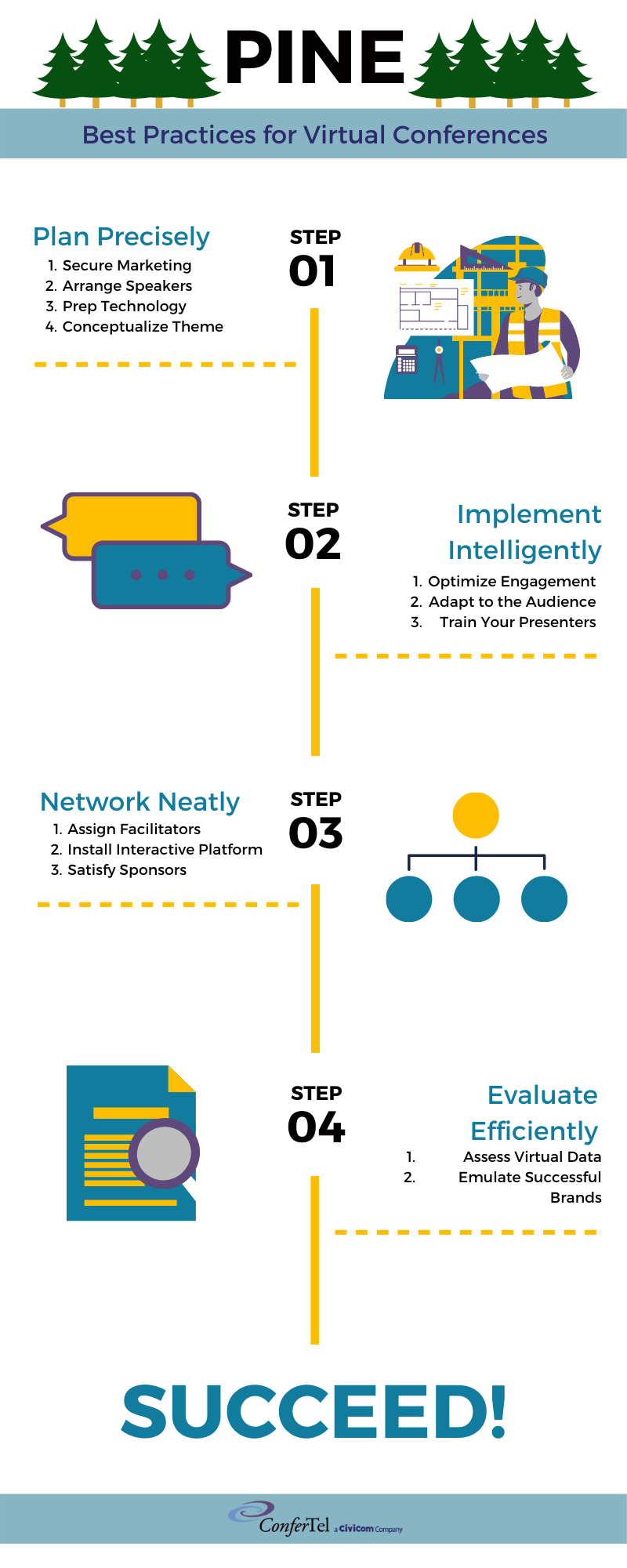It’s been almost a year since COVID-19 protocols started but the battle is far from over. Until then, it’s important to continue business with safety precautions to keep the economy going.
Migrating your physical conferences virtually is an example of this. There were already numerous benefits that virtual conferences provide to businesses, but attempts to minimize risks of virus exposure have caused virtual events to gain greater traction.
If you’re a newbie to the game, you might struggle to compete against the more experienced businesses. Planning and implementing a virtual shindig isn’t as hard as you think.
We’ve taken the best practices for virtual conferences and organized them into this guide. To PINE is to plan precisely, implement intelligently, network neatly, and evaluate efficiently.
Step 1: Plan Precisely

Determine the success of your virtual conferencing event with these objective marks. Similar to physical conferences, virtual conferences rely on turn-out, engagement, and follow-through rate. In layman's terms, people need to attend, interact, and buy.
Secure Marketing
Reach these marks through a good marketing scheme. Determine your target audience and inform them of the event. After they’re aware, entice them to attend. Good event marketing sets an expectation that is fulfilled once the customer bites.
Use social media as an example. Eventbrite reports 25% of traffic to event registration comes from social networks. Tweets, spiels, and captions posted at the right time are effective. If you’re not convinced, Drift reports that Wendy’s generated an additional $64 million in profits from 2017-2018 due to social media. The more presence you have, the better.
Arrange Speakers
Good content provides positive engagement rates. For virtual conferences, this is in the form of great speakers. A great speaker delivers his message so that it resonates with your event’s goals and with the audience.
Choose credible experts as speakers. The audience will pay attention if they feel they can learn valuable insights. Get someone with a large following and you can leverage your platform to promote their business. In return, you get to market your brand to their audience. This effort ensures you don’t disappoint your potential customers.
Prep Technology
Technology is convenient, but it is also finicky. For a successful event, be aware of the pain points of conference calling that can ruin the flow of your set-up. You should also choose the right conference call service that suits your needs. Treat your virtual platform like a venue. Adapt to make it secure, accessible, and logistically manageable.
Conceptualize Theme
Have a centralized theme to avoid confusing your audience. Give them expectations to uphold so you give yourself an easier chance to fulfill them. Remember to reinforce the theme of your event in your branding and other marketing materials.
Step 2: Implement Intelligently
Properly execute your program so your audience can participate. This means your event should run smoothly and account for the dynamics of the virtual platform where it is held. Optimize your engagement strategies for your audience and make sure your speakers are prepared so you avoid things going poorly.
Optimize Engagement
There are many ways to optimize virtual engagement, but the best is to cater to the common forms of online engagement that people go through normally. Live streams, Q&As, comment sections, everything you see in social media, are effective mediums because they aren’t unfamiliar. If you use a new platform, give your audience time to learn it so they can engage effectively.
Adapt to the Audience
Note short attention spans. Virtual events lack real-time stimuli that entertain your audience. Segregate your content so your attendees can breathe, internalize, and engage. If your event relies heavily on speakers, a good rule of thumb is the Pomodoro.
Train Your Presenters
Prep your presenters for a virtual conference the way you would for a physical event. It’s imperative they know their message so the audience can understand their presentation. If the attendees don’t understand, they won’t engage. Maximize visual materials if necessary to enhance participation.
Step 3: Network Neatly
Networking is invaluable to physical conferences, but in a virtual setting, this doesn’t always translate well. Find a way around this to get more customers.
Breakout rooms, for example, are great networking schemes. They are small rooms inside your virtual platform where people can follow another program. It’s like what you see in physical settings with a huge conference hall hosting small activities simultaneously occurring within it. This allows participants to choose what interests them and interact with like-minded individuals.
Assign Facilitators
Appoint facilitators to avoid lulls in conversation. The same way a host entices people to participate in a physical setting; a facilitator inspires conversation in a forum or chat room. Planning an event with a large audience? Have multiple facilitators or opt for operator assistance so all participants get their questions answered.
Install an Interactive Platform
Give your participants a chance to interact not only with the presenters but also with each other. Camaraderie is a powerful tool that elicits positive responses. Use this to your advantage with a variety of messaging and platform tools.
Satisfy Sponsors
Sponsors are common in events. If you have any, don’t forget to take their investment into account. Add activities in your event agenda that sponsors can take advantage of while also providing value to audiences.
Step 4: Evaluate Efficiently
Be aware of the goals you achieve and the marks you miss in a project. Data-tracking helps you improve quickly and consistently as long as you analyze your results efficiently.
Assess Virtual Data
A virtual setting has an advantage over a physical setting because you get real-time data on the spot without worrying about a lack of permanence. Obtain data easily through polls, surveys, and comments, so you can turn the tides if an event isn’t going as planned.
Emulate Successful Brands
Virtual conferencing isn’t new. Many companies are successfully transitioning their events online. Study them to learn what you can.
Regardless of your thoughts on using online platforms, virtual conferences aren’t going anywhere. Take the time to grow with the medium, and you can always refer to this guide when you need help.

